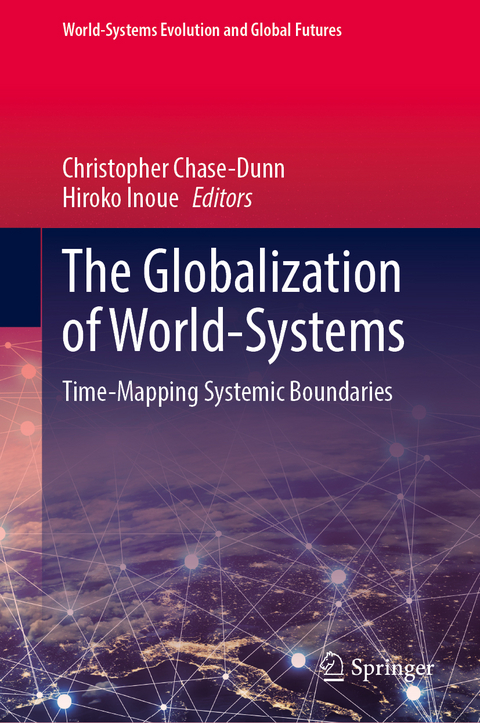
The Globalization of World-Systems
Springer International Publishing (Verlag)
978-3-031-32916-6 (ISBN)
- Noch nicht erschienen - erscheint am 13.06.2025
- Versandkostenfrei
- Auch auf Rechnung
- Artikel merken
This volume explores the spatial and temporal boundaries of whole systemic interpolity systems (world-systems) since the Stone Age. By delineating boundaries of integration based on political/military interaction and on long-distance trade, it compares entire systems of human interaction to examine their similarities and differences, while also addressing the causes of long-term increases in the scale and complexity of human polities and interaction networks. The growing awareness of Eurocentrism suggests the need to systematically compare the world-system that emerged in Europe with interstate systems that existed in other regions and in the more distant past to test hypotheses about the general causes of structural changes - especially the emergence and development of sociocultural and organizational complexity and hierarchy. This book develops a systematic method for determining when and where regional interaction systems merged with one another to become the global system that we have today. Defining interstate systems as networks of polities that make war and form alliances with one another, the contributing authors formulate explicit decision-making rules for specifying the spatial and temporal extent of these important geopolitical and trade interaction networks, starting with those regions in which large cities first appeared. An improved, scientific grasp of interstate systems has important implications for explaining the evolution of human economic, geopolitical, and cultural institutions in the past and for better comprehending the possibilities and probabilities of further geopolitical evolution in the twenty-first century.
lt;p>Christopher Chase-Dunn is a Distinguished Professor of the Graduate Division and director of the Institute for Research on World-Systems at the University of California-Riverside, USA, and founding editor of the Journal of World-Systems Research. His research focuses on the causes of human socio-cultural evolution, global state formation and the democratization of global governance.
Hiroko Inoue is the Assistant Director of the Institute for Research on World-Systems at University of California-Riverside, USA. Her research interests are world-systems analysis, East Asian piracy and East Asian regional systems, evolutionary comparative analyses of firms, cities, nation-states and empires, formal simulation modeling, global inequality, and the application of quantitative and network analyses methods to these topics.
Chapter 1: Time Mapping Globalization: Spatio-temporal Bounding of Human Sociocultural Interaction Systems (Christopher Chase-Dunn).- Part I: Decision Rules.- Chapter 2. High Bar Rules of Thumb for Time-Mapping Systemic Human Interaction Networks (Christopher Chase-Dunn).- Chapter 3. Network Boundaries and Systemness (Robert A. Hanneman).- Chapter 4. When States-Systems Unite: Spatio-temporal boundaries and transition issues in the unification of the Central, Far Eastern, and Indic states-systems (David Wilkinson).- Chapter 5. Systemic Boundaries and Mathematical Modeling of the World System (Andrey Korotayev).- Chapter 6. The Information Network in Premodern Hierarchical World-Systems (Teresa Neal).- Part II: Fuzzy Zones.- Chapter 7. Bounding the Fuzzy Zones at the Edges of World-Systems (Thomas D. Hall).- Chapter 8. Incursions, Climate Change, and Early Globalization Patterns (William R. Thompson).- Chapter 9. The Irish and the Vikings on the Edge of Central Civilization (Robert A. Denemark).- Part III: Spatio-Temporal Cases.- Chapter 10. Afro-Eurasian Systemic Connections (E. N. Anderson).- Chapter 11. World-System Cycles Since 1000 BC: Temporal Boundaries and Factors Affecting the Pulse of the System (Philippe Beaujard).- Chapter 12. From the Nanhai to the Indian Ocean and Beyond: Southeast Asia in the Maritime 'Silk' Roads of the Eurasian World Economy, 200 BCE - 500CE (Sing C. Chew).- Chapter 13. The North American Continental System: A Perspective from the Western Periphery (Mikael Fauvelle).- Chapter 14. Tribute-Trade System and Maritime Capitalism in Early Modern East Asia: The Rise and Fall of Koxinga (Ho-Fung Hung).- Chapter 15. Pirates, bandits and steppe nomads in the development of the East Asian world-system (Hiroko Inoue).- Part IV: Unresolved Issues and Ways Forward.- Chapter 16. Contentious Issues in the Spatio-Temporal Bounding of Systemic Interpolity Networks.
| Erscheint lt. Verlag | 13.6.2025 |
|---|---|
| Reihe/Serie | World-Systems Evolution and Global Futures |
| Zusatzinfo | Approx. 340 p. |
| Verlagsort | Cham |
| Sprache | englisch |
| Maße | 155 x 235 mm |
| Themenwelt | Sozialwissenschaften ► Politik / Verwaltung ► Vergleichende Politikwissenschaften |
| Sozialwissenschaften ► Soziologie | |
| Schlagworte | Bronze Age • East Asian world-system • Eurocentrism • Geopolitics • Globalization • Historical Geography • Human interaction networks • Multipolar global authority structure • Pre-Modern hierarchical World-Systems • Sociocultural systems • Spatial and temporal boundaries of interpolity systems • Systemic boundaries of human societies • Systemic changes of human societies • Systemic interpolity networks • world-systems |
| ISBN-10 | 3-031-32916-3 / 3031329163 |
| ISBN-13 | 978-3-031-32916-6 / 9783031329166 |
| Zustand | Neuware |
| Haben Sie eine Frage zum Produkt? |
aus dem Bereich


